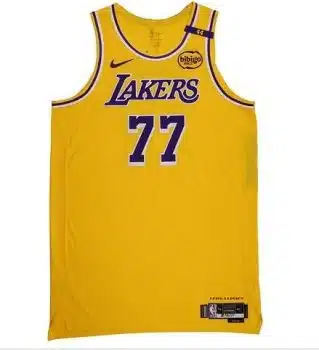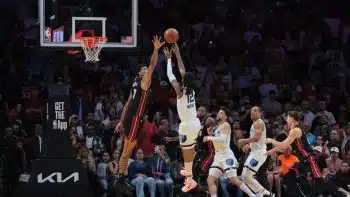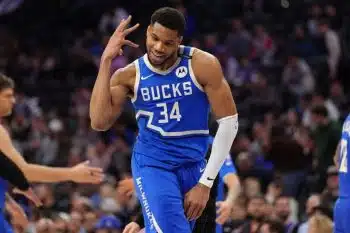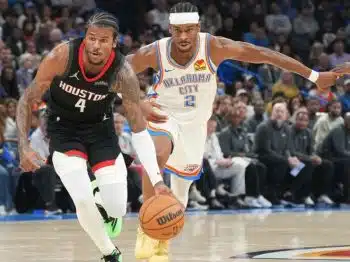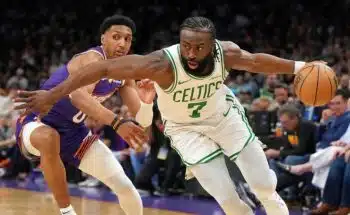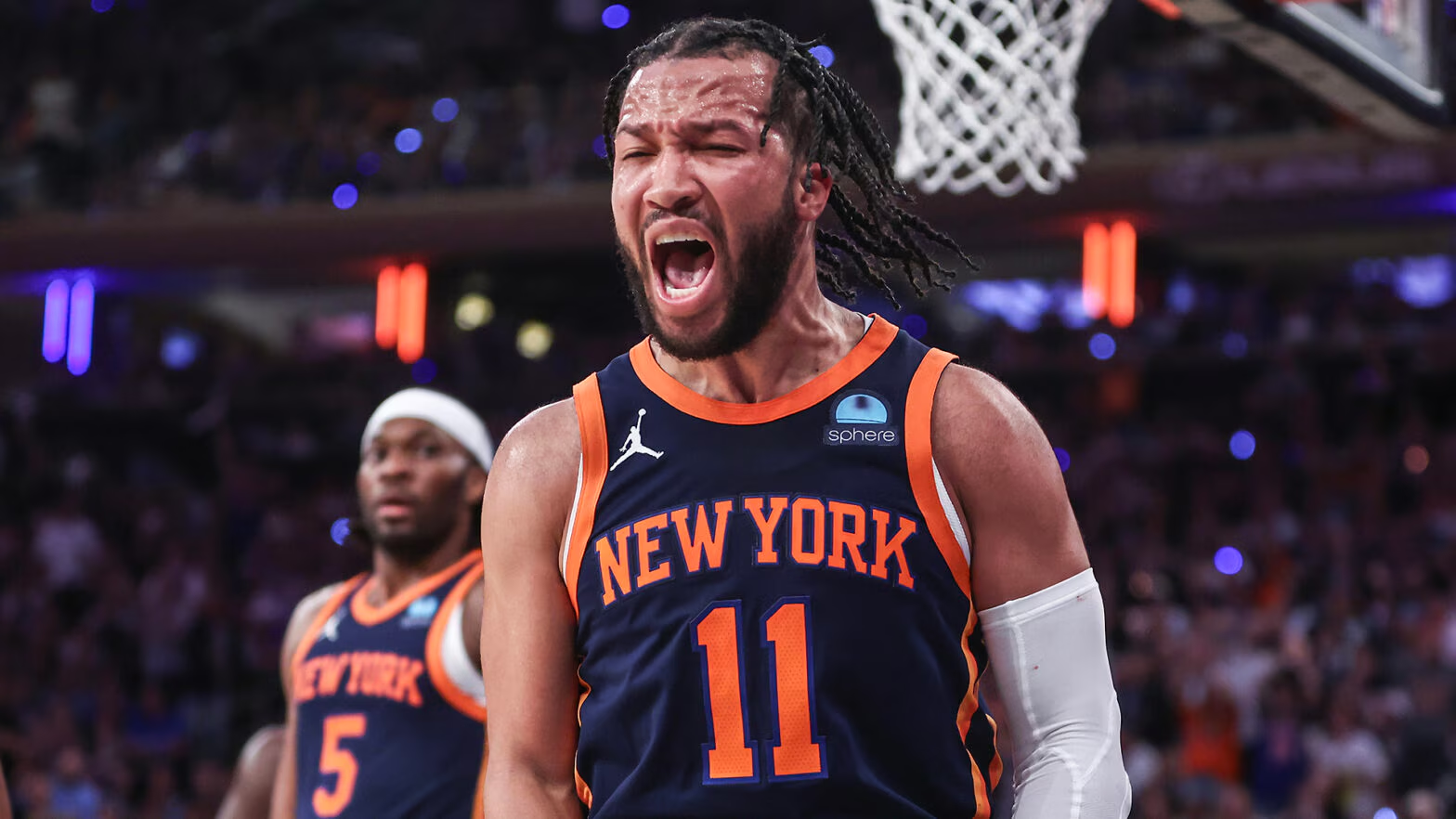NBA
Most Improved Player Watch
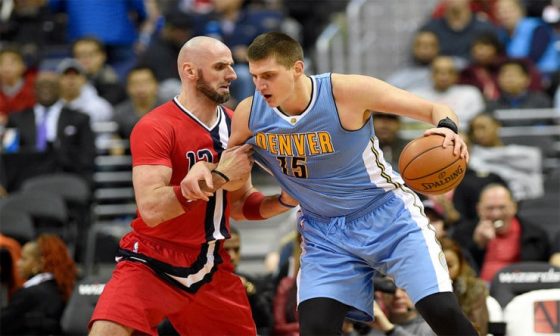
Although a fairly broad consensus has formed regarding who should win the 2017 Most Improved Player Award, the field is actually quite crowded with players deserving of consideration. Herein we count down the candidates using a mix of stats to show their year-over-year improvement.
This table includes per 36 minute stats, true shooting and usage percentage, Player Efficiency Rating and SportVU’s defensive differential percentage for the last two seasons for the players listed below. SportVU has optical tracking cameras in all 29 NBA arenas and utilizes algorithms that determine defensive assignments 25 times per second. Defensive differential is the difference between shooting percentage when guarded by the player and the season average for opposing shooters.
15. Russell Westbrook, Oklahoma City Thunder
Oklahoma City’s last remaining superstar has increased his per 36 minute scoring from 24.6 to 32.6 this season. He’s in the midst of a historic campaign that could see a player average a triple-double for a season for the first time since Oscar Robertson did it in 1970-71. How can Westbrook not be higher on this list? The answer lies in the massive 10.3 percent jump in usage since last season. Westbrook is also averaging nearly three more rebounds per 36 minutes, but opponents are shooting four percent above their season average when he guards them, more than a two percent increase over last season.
14. Tim Hardaway Jr., Atlanta Hawks
As the Atlanta Hawks bumble their way toward another middling playoff seed, lost in the uninspiring story of their season is the breakout of Tim Hardaway Jr. Atlanta’s sixth man increased his per 36 scoring by nearly six points, although his true shooting percentage remained flat around 56 percent. The increased scoring output correlates to a better than six percent increase in usage, although he did jump from 42nd to 17th in PER among shooting guards. Once labeled a defensive liability by Knicks team president Phil Jackson, Hardaway has posted consecutive impressive defensive seasons in Atlanta.
13. Seth Curry, Dallas Mavericks
Curry went from appearing in 44 games (nine starts) and playing 692 minutes last season to 65 appearances, 37 starts and nearly 1900 minutes so far this season. He did see a two percent uptick in usage while his PER increased from 13.8 to 15.4. But looking at his per 36 minute stats, they’re nearly identical year-over-year. That’s not to say Curry didn’t improve. To maintain a similar rate of production in nearly triple the minutes and four times as many starts has significance. Incredibly, Curry is holding opposing shooters nearly eight percent lower compared to last season. However, the level of improvement doesn’t push Curry higher on this list.
12. Clint Capela, Houston Rockets
Capela’s assists stayed roughly the same while he is committing nearly half a turnover more per 36. Impressively, his true shooting percentage jumped by nearly eight points. Ultimately, his three-point bump in PER is largely explained by an increase of over four percent in usage. The NBA is an opportunity league and Dwight Howard’s defection to Atlanta has opened up plenty of opportunities for Capela in Houston.
11. Isaiah Thomas, Boston Celtics
Most of Thomas’ per 36 stats have remained flat, but he has jumped from 24.8 to 30.7 points per 36. He’s also seen a five-point increase in PER, but it’s accompanied by a usage increase of nearly five percent. He should absolutely be lauded for posting a career-best in true shooting (62 percent), which is a six percent improvement from last season. However, opponents are shooting two percent higher when guarded by Thomas compared to last year.
10. Anthony Davis, New Orleans Pelicans
Davis has stepped up in scoring with a career-high 27.7 points per 36 minutes, a full three points better than last season’s previous high. He also stepped up in rebounding, pulling down a career-best 16 per 36, a 1.5 rebound improvement over last year. As with Westbrook — though to a lesser degree — much of Davis’ improvement can be attributed to a three percent uptick in usage. He does deserve a ton of credit for holding opposing shooters nearly six percent below their average, a differential that is almost twice as good as what he posted last season. Prior to the arrival of DeMarcus Cousins, Davis was called upon to fill the stat sheet due to the overall talent-deficit on the Pelicans’ roster.
9. Harrison Barnes, Dallas Mavericks
Barnes’ per 36 scoring exploded from his previous career-high of 13.6 points in his final season with Golden State to 20 per 36 this season. However, his true shooting percentage and per-minute rebounding decreased slightly while assists decreased and turnovers increased. The latter is doubtlessly explained by having much more proficient scorers to pass to last season in Oakland. As with Westbrook, the huge increase in production is linked to a massive 10 percent increase in usage. With the Dallas Mavericks three games out of the eighth playoff seed in the Western Conference, it’s fair to wonder how much of this is an improvement and how much is simply increased opportunity on a team desperate for scoring.
8. Myles Turner, Indiana Pacers
As the Pacers creep toward overtaking the Hawks for the fifth seed, Myles Turner is a major reason why Indiana is making some noise in the East. Although his per 36 stats are fairly consistent with his rookie season, Turner upped his PER by three points while his usage actually decreased by one percent. Turner compiled 25 steals as a rookie but already has 63 this season. He’s also taken a step up defensively, holding opponents four percent below their average. It seems like selling Turner short to rank him eighth, but despite a stellar sophomore campaign, the list is simply too crowded.
7. Kawhi Leonard, San Antonio Spurs
It’s tough to gauge improvement when a player is already so good. Leonard’s scoring has jumped by five points per 36 but his usage is up by more than five percent as well. Interestingly, Leonard is having an off season defensively (for his standards), allowing opponents to shoot nearly five percent higher than last season. Leonard won’t have a strong enough case for Most Improved Player, so he may just have to settle for MVP.
6. Gordon Hayward, Utah Jazz
Hayward has upped his scoring by more than three points per 36, improved his rebounding and cut down on turnovers. He’s also improved his true shooting slightly while impressively holding opposing shooters four percent lower than last season. Here again, despite a four-point leap in PER, it’s not a strong enough case to crack the top five.
5. Bradley Beal, Washington Wizards
Basketball Insiders senior writer Ben Dowsett made a convincing argument for Beal to be among the top contenders for this award. Most of his jump from a 15.5 PER to 20.2 resulted from an increase of just under four points per 36 on true shooting that increased from 55 to nearly 61 percent. The bulk of his per 36 stats stayed flat while rebounding decreased. However, his bump in offensive production can’t be explained away by a jump in usage, which only increased by just over one percent.
4. Otto Porter, Washington Wizards
Thanks to spending much of the season with the league lead in three point percentage, Porter’s true shooting percentage skyrocketed from 56 percent to nearly 64 percent this season. The Wizards’ wing has also shown improvement in assist-to-turnover ratio. While his assists per 36 minutes decreased slightly from 1.9 to 1.7, he nearly cut his turnovers in half from 1.1 to a career-low .6 per 36. He managed a three point jump in PER while seeing his usage actually decrease by one percent, a testament to his supreme efficiency.
3. Rudy Gobert, Utah Jazz
Of particular note for Gobert is a quantum leap from 58 percent true shooting last season to nearly 68 percent this season. His PER took a major jump from 17.5 to 22.4, and he accomplished all of this while seeing his usage increase by a mere two percent. In any other season, it would be shocking if such accomplishments didn’t put Gobert at the head of the class in this discussion. But this is no ordinary season as the two stars below have gone supernova at an early stage in their respective careers.
2. Nikola Jokic, Denver Nuggets
Nikola Jokic is part of a big man renaissance that is sweeping the NBA, joining a herd of unicorns that includes Anthony Davis, Karl-Anthony Towns and Kristaps Porzingis. His steals per 36 fell off from 1.6 as a rookie to just one this year while his assists per 36 jumped from 3.9 to an unimaginable 6.2. This was accompanied by only a slight increase in turnovers. Meanwhile, his true shooting percentage jumped from 58 percent to over 64 percent while his PER increased by nearly five points. All this was accomplished with a modest three percent increase in usage.
All of this equates to an offensive, creative force that will have NBA coaches losing sleep for the next decade-plus. How do you guard a player near seven-feet tall that can pass like a point guard and stretch the floor like a shooting guard? The only downfall for Jokic is that opponents are shooting five percent above their season average when he guards them, an increase of six percent compared to last season.
1. Giannis Antetokounmpo, Milwaukee Bucks
If you look at ESPN.com’s stats page for the Milwaukee Bucks, you see a whole lot of the Greek Freak’s smiling face under the team leaders header. He might have become the first player to lead an NBA team in points, assists, rebounds, blocks, steals and field goal percentage for a full season, but he currently trails Greg Monroe and Michael Beasley in the latter category.
Antetokounmpo’s PER jumped by more than seven points, which is astounding even with an accompanying increase of nearly six percent in usage. He distinguishes himself from Jokic by holding opponents 3.4 percent below their season average. And his true shooting has jumped from 57 percent to nearly 61 percent while he’s added a rebound, half a steal, half a block and a full assist per 36. To be an NBA fan right now is like watching the night sky come alive with new stars forming new constellations. Giannis is the latest iteration of something the NBA seems to continuously gift us with … something we’ve never seen before. Needless to say, Antetokounmpo has a very strong case for this year’s Most Improved Player award.
